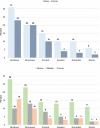Caesarean section in Sudan: findings from nationwide household surveys on rates, trends, and geographic and sociodemographic variability
- PMID: 36127631
- PMCID: PMC9487139
- DOI: 10.1186/s12884-022-04995-3
Caesarean section in Sudan: findings from nationwide household surveys on rates, trends, and geographic and sociodemographic variability
Abstract
Background: Medically unjustifiable caesarean section (CS) deliveries have been rising rapidly in many developed countries over the last three decades. While many developing countries show rates beyond optimal levels, few poorer countries appear to have sub-optimal obstetric care in relation to essential surgeries. The objective of this study is to document the rates of CS delivery, its time trend, and geographic and sociodemographic variability in Sudan.
Methods: We utilized a number of Multiple Indicator Cluster Surveys (MICS) conducted in 2014, 2010, and 2006 to quantify CS rates per 1000 live births. We also documented absolute changes in rates over three-time points and variation in CS rates across geographic regions and areas of residence.
Results: Over a decade, CS rates in Sudan increased steadily from 4.3% in 2006 to 6.7% in 2010 and 9.1% in 2014. During this period, CS rates varied considerably across regions showing higher rates in the Northern region (7-25%) and lower rates in Darfur (2-3%). Urban areas experienced rapidly increasing rates (6-14%), while rural areas showed negligible changes to absolute CS rates over time (5-7%). We also found geographic regions, maternal age, maternal education, receiving antenatal care, and birth order of the child were important determinants of CS in Sudan.
Conclusion: Sudan may be facing a double burden of problems associated with surgical interventions for childbirth. While the wealthier parts of Sudan are experiencing a rapid surge in CS, some poor parts of rural Sudan may not be getting the essential surgical intervention for birth when mandated. Urgent improvement to obstetric care and the development of appropriate public health interventions that focus on regional disparities are warranted.
Keywords: Area of residence; Caesarian section; Determinants; Inequalities; Regional variability; Sociodemographic; Sudan; Trend; Wealth.
© 2022. The Author(s).
Conflict of interest statement
The authors declare that they have no competing interests.
Figures


Similar articles
-
Caesarean section and associated factors in Nigeria: assessing inequalities between rural and urban areas-insights from the Nigeria Demographic and Health Survey 2018.BMC Pregnancy Childbirth. 2024 Aug 14;24(1):538. doi: 10.1186/s12884-024-06722-6. BMC Pregnancy Childbirth. 2024. PMID: 39143541 Free PMC article.
-
Trends and sociodemographic inequalities in the use of caesarean section in Indonesia, 1987-2017.BMJ Glob Health. 2020 Dec;5(12):e003844. doi: 10.1136/bmjgh-2020-003844. BMJ Glob Health. 2020. PMID: 33380412 Free PMC article.
-
Magnitude and trends in socio-economic and geographic inequality in access to birth by cesarean section in Tanzania: evidence from five rounds of Tanzania demographic and health surveys (1996-2015).Arch Public Health. 2020 Sep 15;78:80. doi: 10.1186/s13690-020-00466-3. eCollection 2020. Arch Public Health. 2020. PMID: 32944238 Free PMC article.
-
Global epidemiology of use of and disparities in caesarean sections.Lancet. 2018 Oct 13;392(10155):1341-1348. doi: 10.1016/S0140-6736(18)31928-7. Lancet. 2018. PMID: 30322584 Review.
-
Caesarean section in countries of the Eastern Mediterranean Region.East Mediterr Health J. 2008 Mar-Apr;14(2):470-88. East Mediterr Health J. 2008. PMID: 18561740 Review.
Cited by
-
Increasing the number of midwives is necessary but not sufficient: using global data to support the case for investment in both midwife availability and the enabling work environment in low- and middle-income countries.Hum Resour Health. 2024 Jul 22;22(1):54. doi: 10.1186/s12960-024-00925-w. Hum Resour Health. 2024. PMID: 39039518 Free PMC article.
-
Prevalence and associated factors for preoperative anxiety among women undergoing elective cesarean delivery in eastern Sudan: a cross-sectional study.BMC Pregnancy Childbirth. 2025 Feb 24;25(1):199. doi: 10.1186/s12884-025-07308-6. BMC Pregnancy Childbirth. 2025. PMID: 39994585 Free PMC article.
-
Overlapping social structures behind Brazil's cesarean section births: A decomposition analysis.PLoS One. 2025 Jun 25;20(6):e0325251. doi: 10.1371/journal.pone.0325251. eCollection 2025. PLoS One. 2025. PMID: 40561132 Free PMC article.
-
Determinants of Cesarean Delivery During Wartime in Atbara, Sudan: A Case-Control Study.Cureus. 2025 Jan 8;17(1):e77130. doi: 10.7759/cureus.77130. eCollection 2025 Jan. Cureus. 2025. PMID: 39925490 Free PMC article.
References
MeSH terms
LinkOut - more resources
Full Text Sources
Medical

